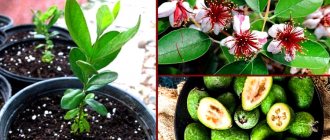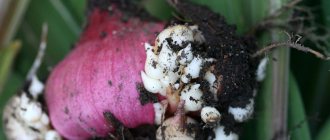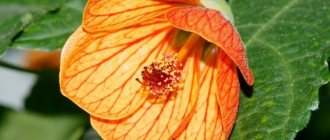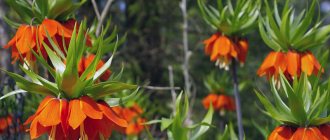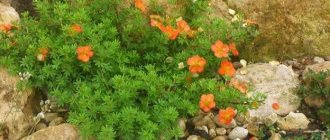Thuja - planting and care
Elegant thuja trees or shrubs are valued for the beauty of their thick crown, amazing surface relief, and rich color. Like any other garden plant, thuja needs to comply with the basic rules of agricultural technology, but in general it manifests itself as an unpretentious plant, full of energy, capable of thriving in the most modest conditions.
Site selection and soil preparation
For planting thujas, areas exposed to the sun or sparse partial shade are preferred; in this case, the plants develop harmoniously, the needles are fully colored, showing all shades of color, differences in dark and light tones. In deep shade, the crown becomes loose, the needles become sparse, and the color becomes dull.
However, young and dwarf plants do not tolerate full sun; sparse partial shade from nearby clematis, birch or rowan trees is acceptable and desirable. When choosing a location and selecting other crops, it is worth assessing what the green corner will look like in 10–20 years, since this conifer is a long-liver and an initially bright area may turn out to be shady in the future.
Thuja is undemanding to soil and works well in moderately moist neutral, slightly alkaline and slightly acidic soils. It survives on very poor soils, but loses its decorative properties, is stunted in growth, and sometimes begins to bear fruit abundantly, which does not look very attractive on sparse branches.
When choosing a thuja variety, first of all, you should pay attention to the species:
- Western thuja is considered the most versatile species, more resistant to cold than others.
- Eastern thuja tolerates dry, hot periods more easily and is suitable for the southern regions.
- Large thuja in northern latitudes are prone to frost.
Heavy, moisture-saturated soils are not suitable for planting; such areas must be drained in advance, removing excess water. For small plants, it is permissible to arrange drainage directly in the planting hole, for which a layer of broken brick, crushed stone, and expanded clay at least 20 cm thick is poured onto the bottom. Dwarf varieties can be successfully grown in a low-lying area by arranging a rocky hill and planting a tree on its slope.
The area for planting is prepared in advance; for spring planting, in the fall. After cultivation, holes are dug for tall varieties with a diameter of 1 m and a depth of at least 70 cm, for dwarf varieties - at least 50x50 cm. Drainage is immersed in the bottom, then a nutritious, loose hygroscopic substrate is poured, for which the following is mixed:
- turf soil - 2 parts;
- peat – 1 part;
- sand – 1 part;
- humus-powder - 0.5 parts.
After the snow melts, the settled soil is replenished with earth mixture to the previous level.
How to choose seedlings when purchasing?
How to choose thuja seedlings?
Seedlings are purchased from nurseries or garden centers with a solid reputation. The best option is plants in containers with a closed root system. Such planting material can be planted at any time of the year, but the optimal period is spring, in which case the thuja will have time to take root, and the resulting growths will ripen well by winter.
If a nursery sells seedlings “from the field,” it is advisable to pick them up as quickly as possible. At the same time, they try to keep a lump of damp earth on the roots by wrapping it tightly with burlap or film.
You should not purchase seedlings with an open root system, especially “from hand” on the market; they may turn out to be not only weakened, with dried roots and shoots, but also infected with a fungal infection, for example, rust.
When choosing planting material, pay attention to the correspondence of the shape of the crown and the color of the needles to the required variety. It is better not to take plants with bare branches and browned crowns.
If long pieces of roots stick out through the drainage holes in the container, the seedling is rejected. If the roots have just appeared, this means that the earthen ball is well mastered by the root system and the plant will take root better.
Botanical description
Thuja are evergreen shrubs or trees, sometimes in nature reaching 70 m in height with a trunk diameter of 6 m. In cultivation, thuja rarely grows above 11 meters. Young thujas have needle-shaped, soft, light green needles, while adults have leaves of a darker green hue, opposite, scale-like. Thujas are monoecious plants, their fruits are oval or oblong cones with flat seeds that ripen in the first year. Thuja is not capricious in care, it is smoke-resistant, cold-resistant, and a species such as the western thuja tolerates even cold winters well.
Planting and replanting thuja
Planting of seedlings is carried out in the early stages, as soon as the weather permits and the soil dries out. Before planting, container specimens are well watered for several hours. In a hole filled in the fall, dig a hole 30 cm wider and deeper than the container, and plant the plant, carefully straightening out the loose roots. They try not to destroy the earthen ball, but shake off part of the substrate.
Saplings with an open root system are inspected, damaged roots are removed and immersed in water for two to three hours, and immediately before planting they are treated with Kornevin or Zircon and sprinkled with Fundazol powder. A hole is dug 20–30 cm wider and 30–40 cm deeper than required by the root system, a mound is made at the bottom and the roots are distributed, after which it is sprinkled with loose soil, being careful not to deepen or expose the root collar - it should be at the level soil.
The plant is watered by adding a root formation stimulator to the water, the soil is compacted, the surface of the hole is covered with lutrasil and mulched with peat.
Unlike junipers, adult thuja tolerates replanting , which is carried out on a cool spring day, trying to preserve the earthen lump. Experienced gardeners, ahead of time, in the fall, cut through the soil with a shovel along the line of digging up the thuja, then the roots will have time to heal, young roots will appear, and the tree will take root faster.
When transplanting, water is poured into the hole and mixed with soil, the plant is planted in the slurry, covered with soil, compacted and watered again. The surface is covered with geotextile and mulch is laid; crushed pine bark or cones can be used.
Compatibility with other plants
In order to beautifully plant thuja on a site, as in the photo below, you need to choose the right neighbors for it. This plant is recommended to be planted near playgrounds and children's institutions, since, like all conifers, it releases phytoncides that cleanse the air of pathogenic microorganisms and dust. Thuja needles are softer than those of pine or spruce. Therefore, it is safer for children.
Thuja care
Thuja hedge
Thuja is not a very demanding tree, it requires low maintenance, is tolerant of pruning and grows well even in polluted urban areas. The main agrotechnical techniques for growing thuja are watering, fertilizing, pruning, preparing for winter, as well as disease and pest control.
Watering
Thuja is more moisture-loving than juniper, and during dry periods it is watered up to twice a month. Using mulch will help retain moisture and keep the soil porous, and will stimulate the development of beneficial microorganisms, in particular mycorrhizae. The root system of the thuja is located close to the soil surface, so it is loosened carefully, not going deeper than 10 cm.
Thuja foldata is more demanding on watering , often damp areas near the water. Therefore, varieties of this species can be planted even in areas too wet for pines and junipers.
Eastern thuja , on the contrary, tolerates dry periods well, and in this quality is significantly superior to western and folded thuja .
Watering is carried out gradually, evenly and deeply moistening the soil; it is advisable to use sprinkling. Immediately after planting, the seedlings are watered more often - every week, spending at least 15 liters per plant. The most demanding of moisture are dwarf thujas , as well as specimens planted on rocky hills.
Feeding
Properly filled pits will provide enough nutrients for the full development of seedlings. And yet, you can feed the thuja once or twice a season, this will enhance development and give the needles a rich color.
The first time feeding is carried out at the end of May, improving the growth of the root system, for which potassium sulfate is diluted at the rate of 3 tablespoons per 10 liters of water. This amount will be enough for one adult tree or shrub; 1–2 liters are added to a young plant.
The second time, at the end of August or beginning of September, granular fertilizer for conifers with a prolonged effect, containing the entire complex of macro- and microelements, is applied. Well-known brands Royal Mix, Compo and Agricola performed well. The granules are embedded in the soil along the perimeter of the crown; this fertilizing will strengthen the conifers, strengthen both the crown and the root system, which is important for successful wintering.
Trimming
Thuja pruning
To form a slender tree, multi-stemmed seedlings are left with one of the strongest shoots in the group, the rest are cut out with pruning shears, sprinkling the sections with Fundazol, and large damage is covered with garden varnish.
Formative pruning of thuja is carried out by cutting the shoots by 1/3 of the length to obtain a thick, dense crown. Such pruning should not be carried out more often than once every few years.
Sanitary pruning is carried out early, as soon as the plants emerge from dormancy. At the same time, dry branches are removed and those damaged during wintering are pruned. Then you should trim the protruding shoots if they break their shape. Strongly growing or crooked branches that look unnatural are pruned at the very trunk.
To form hedges, the apical shoots are cut off every year, trying to thicken the bush; operations are carried out until mid-July so that the shoots become woody in the winter. It should be borne in mind that massive pruning of branches to a length of more than 1/3 greatly weakens and inhibits growth. You cannot cut several branches from an adult tree at once, this can lead to its illness or even death.
Pest and disease control
Weakened thujas in unfavorable conditions can be affected by fungal diseases, and they are often attacked by various insects.
Pests
Hermes , which looks like a grayish fluffy aphid, feeds on the sap of pine needles; the thuja is harmed by both adult insects and voracious larvae.
Thuja false scale damages the branches, which is visible in the form of elongated light brown sores, the shoots dry out, the needles turn yellow and crumble.
Small greenish caterpillars of sawflies eat up the needles on young tender growths; in severe cases, the areas appear burnt.
In early spring, even before growth appears, the plants are inspected and, if necessary, treated with Decis, Enzhio or Actellik. The development of populations of most insects occurs in waves, so at least 2-3 treatments are carried out every 7-10 days, changing the preparations.
Diseases
Indirect causes of fungal diseases of thuja are too thick crown, ill-conceived dense shelter for the winter, shading, prolonged damp weather. An outbreak of fungal infections can occur on the lower part of the crown, which is under snow for a long time and is not ventilated.
Schutte brown is noticeable in the fall in the form of yellow dots, which in the spring turn into brown spots with a thin blackish-gray coating. Browned needles remain on the branches, which gradually dry out.
A specific fungal disease - pestalocytic wilt of thuja leads to necrotic lesions of the bark and drying out of branches and needles; greenish-brown tubercles are visible in the infected areas, in which fungal spores are concentrated.
Fusarium spreads in damp, cold weather; from contaminated soil, pathogens enter the roots and rise up through the vascular system, as a result of which the branches, and especially young shoots, dry out. Rust appears as orange pustules on the bark and needles that turn brown and fall off.
In early spring, the plants are inspected, damaged, drying branches are removed, fallen needles are collected and burned. The crown is treated with fungicides, effective are HOM, Skor, 1% solution of Bordeaux mixture, Fitosporin-M. In case of fusarium, a 0.1% solution of Fundazol is added to the root, and Zircon is used to strengthen the root system.
sunburn in early spring ; for prevention, the plants are covered with a special net or old sheets, and for the fastest recovery, the crown is sprayed with stimulants, for example, solutions of Epin or Ecoberin.
Preparing for winter
Thuja in winter
Temperature changes negatively affect the wintering of thuja - from unexpected thaws to severe frosts. These plants do not tolerate prolonged dry, windy weather at low temperatures. Good mulch, autumn fertilizing with long-acting fertilizers and regular watering have a strengthening effect and help avoid freezing.
In addition, the simplest accumulation of snow at the base of the crown will prevent damage to the roots and drying out of the needles. With the onset of early spring, the snowdrift is gradually loosened and stretched along the perimeter of the crown, otherwise fungi will actively develop in a humid environment.
Cover dwarf and young thujas with dead wood, wicker baskets, spruce branches, and reed mats. Such devices allow air to pass through, prevent soil weathering and drying out of pine needles, and retain snow well.
The use of woven shelters (tying with burlap or lutrasil) on conifers is fraught with stagnation of damp air and fungal diseases. If a shelter is still used, you need to monitor the weather and remove materials in time as soon as the threat of severe frost has passed.
What can you water with and what is the effect of it?
To stimulate growth and development, it is recommended to feed the young tree . However, fertilizers can be applied no earlier than 2–3 years after planting. This is explained by the fact that the necessary nutrients are introduced into the soil along with the earthen ball in which the roots of the seedling are located.
When the thuja reaches two years of age, you can begin to feed it with special mineral supplements intended for fertilizing coniferous trees.
Kemira-Universal is well suited for this. The product at the rate of 50 g per m² is diluted in 10 liters of water and watered the area around the plant. Then you need to loosen it. Loosening will allow the fertilizer to be better absorbed into the soil.
Did you know? Thuja is a long-lived tree. Her age can reach 200 years.
Thuja occidentalis is a moisture-loving tree. For its full development and formation, it is necessary to observe the correct watering regime. It must be timely and in sufficient quantity to satisfy the tree's basic need for moisture.
Features of reproduction
Gardeners often propagate thuja by cuttings, less often by grafting. The seed method is used to obtain planting material of species plants, since varietal and hybrid forms do not fully transmit external characteristics to seedlings.
Seed propagation
The oblong, flat seeds of the thuja ripen in the fall. For spring sowing, they are stratified for a month in damp sand on the bottom shelf of the refrigerator. Sometimes experts advise for better germination to carry out longer stratification - up to 3-5 months, and then additionally keep it warm for 2-3 months.
For sowing, prepare a substrate from turf soil, preferably collected from a coniferous forest, mixing it with peat in equal parts. Seeds are sown in furrows to a depth of 1–1.5 cm, watered and mulched with peat or humus chips.
The emerging seedlings are watered, shaded in the heat, and the area is kept clean, carefully pulling out weeds. Seedlings grow slowly, transplantation is carried out after one or two years, during this period two fertilizing sessions are carried out per season with fertilizers for coniferous plants. If there is a threat of fungal infections, crops are treated with Fundazol or Fitosporin-M.
Vegetative propagation
A simple, common method of propagating thuja is through cuttings using lignified or green cuttings. The seedlings obtained in this way fully correspond to the external characteristics of the mother plant.
Partially lignified cuttings with a heel, broken off at the base of the branch in June-July, take root best. Completely lignified cuttings are collected in May, but those obtained in the second half of summer will not have time to take root.
If it is not possible to break off cuttings with a heel, use pruning shears, taking pieces of shoots 2–3 cm long from dwarf varieties, and up to 20 cm from large ones. The cut is made obliquely and treated with Kornevin before planting. You should not take too many growths from the queen cells, as this will greatly weaken the plant.
For planting, use a greenhouse, placing in boxes a mixture of equal parts of sand, peat and turf soil. The cuttings are placed every 10–15 cm, watered with pink potassium permanganate and mulched with peat. The greenhouse is shaded in extreme heat, and regular watering and ventilation are carried out.
Usually, rooting lasts until autumn, and the next year the overwintered seedlings are placed in a permanent place, planted in containers or in a special area for growing.
Successful grafting requires certain skills, but allows you to grow strong seedlings of those varieties and hybrids that do not grow well on their own roots, or standard thujas.
For transferring a plant to “other roots”, two-year-old seedlings are excellent. To grow a standard form, you need to wait several years until the rootstock reaches the desired height, or purchase a ready-made specimen with an even trunk.
Cuttings are taken from 1-2 year old branches in early spring, when the plants are still dormant, stored in the refrigerator, wrapped in a damp cloth and immersed in a tightly closed container, for no more than 10 days. As soon as the buds of the rootstock begin to grow, make oblique cuts of the rootstock and scion, combine them into the butt and wrap them tightly with film. When young needles appear on the scion, the winding is loosened and then removed completely, applying a thin layer of garden varnish.
Consequences of ignoring watering or doing it incorrectly
Failure to comply with the watering regime - its shortage or excess - can lead to dire consequences. Insufficient moisture leads to drying out of the soil and inhibition of root development. Overwatering is no less dangerous for the health of the thuja and can lead to rot and death of the plant.
Check out
What to do if bumps appear on the thuja
It is very important to comply with moisture requirements in hot months , since under solar conditions the needles lose a large amount of moisture. The main condition for caring for a tree in summer is the regular and timely provision of liquid to the young tree.
Watering during this period should be done in the morning, since direct sunlight intensively evaporates moisture from the soil.
Also, as a result of heating and evaporation of liquid from the surface of the needles, it can leave burns on the delicate growth, so it is better to irrigate the crown in the evening, at sunset.
